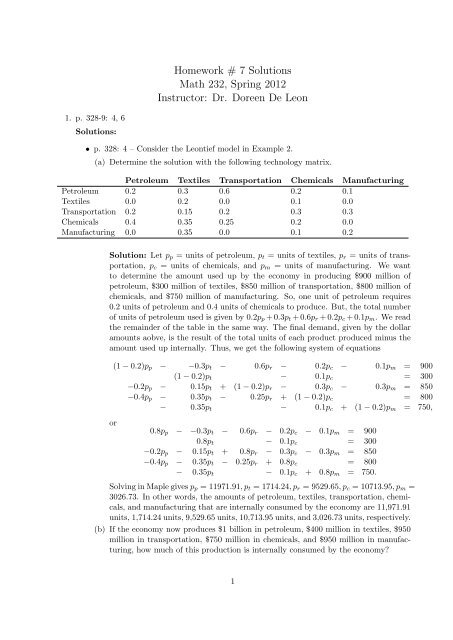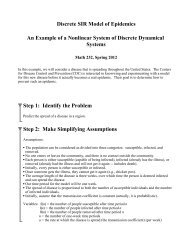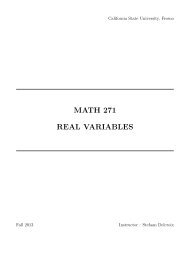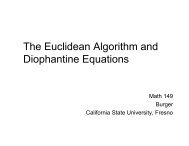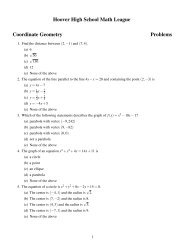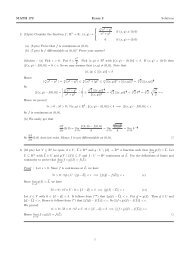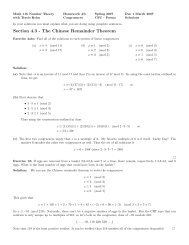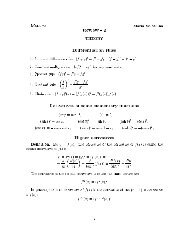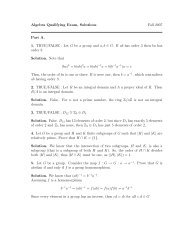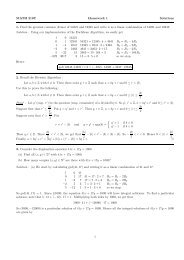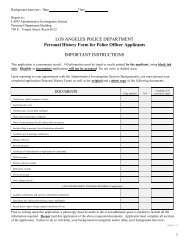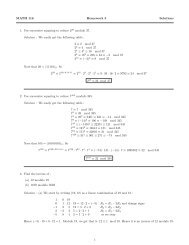Homework # 7 Solutions Math 232, Spring 2012 Instructor: Dr ...
Homework # 7 Solutions Math 232, Spring 2012 Instructor: Dr ...
Homework # 7 Solutions Math 232, Spring 2012 Instructor: Dr ...
- No tags were found...
Create successful ePaper yourself
Turn your PDF publications into a flip-book with our unique Google optimized e-Paper software.
<strong>Homework</strong> # 7 <strong>Solutions</strong><strong>Math</strong> <strong>232</strong>, <strong>Spring</strong> <strong>2012</strong><strong>Instructor</strong>: <strong>Dr</strong>. Doreen De Leon1. p. 328-9: 4, 6<strong>Solutions</strong>:• p. 328: 4 – Consider the Leontief model in Example 2.(a) Determine the solution with the following technology matrix.Petroleum Textiles Transportation Chemicals ManufacturingPetroleum 0.2 0.3 0.6 0.2 0.1Textiles 0.0 0.2 0.0 0.1 0.0Transportation 0.2 0.15 0.2 0.3 0.3Chemicals 0.4 0.35 0.25 0.2 0.0Manufacturing 0.0 0.35 0.0 0.1 0.2Solution: Let p p = units of petroleum, p t = units of textiles, p r = units of transportation,p c = units of chemicals, and p m = units of manufacturing. We wantto determine the amount used up by the economy in producing $900 million ofpetroleum, $300 million of textiles, $850 million of transportation, $800 million ofchemicals, and $750 million of manufacturing. So, one unit of petroleum requires0.2 units of petroleum and 0.4 units of chemicals to produce. But, the total numberof units of petroleum used is given by 0.2p p + 0.3p t + 0.6p r + 0.2p c + 0.1p m . We readthe remainder of the table in the same way. The final demand, given by the dollaramounts aobve, is the result of the total units of each product produced minus theamount used up internally. Thus, we get the following system of equationsor(1 − 0.2)p p − −0.3p t − 0.6p r − 0.2p c − 0.1p m = 900(1 − 0.2)p t − 0.1p c = 300−0.2p p − 0.15p t + (1 − 0.2)p r − 0.3p c − 0.3p m = 850−0.4p p − 0.35p t − 0.25p r + (1 − 0.2)p c = 800− 0.35p t − 0.1p c + (1 − 0.2)p m = 750,0.8p p − −0.3p t − 0.6p r − 0.2p c − 0.1p m = 9000.8p t − 0.1p c = 300−0.2p p − 0.15p t + 0.8p r − 0.3p c − 0.3p m = 850−0.4p p − 0.35p t − 0.25p r + 0.8p c = 800− 0.35p t − 0.1p c + 0.8p m = 750.Solving in Maple gives p p = 11971.91, p t = 1714.24, p r = 9529.65, p c = 10713.95, p m =3026.73. In other words, the amounts of petroleum, textiles, transportation, chemicals,and manufacturing that are internally consumed by the economy are 11,971.91units, 1,714.24 units, 9,529.65 units, 10,713.95 units, and 3,026.73 units, respectively.(b) If the economy now produces $1 billion in petroleum, $400 million in textiles, $950million in transportation, $750 million in chemicals, and $950 million in manufacturing,how much of this production is internally consumed by the economy?1
Solution: We rewrite the above system of equations to reflect the new productionamounts:0.8p p − −0.3p t − 0.6p r − 0.2p c − 0.1p m = 10000.8p t − 0.1p c = 400−0.2p p − 0.15p t + 0.8p r − 0.3p c − 0.3p m = 950−0.4p p − 0.35p t − 0.25p r + 0.8p c = 750− 0.35p t − 0.1p c + 0.8p m = 950.Solving in Maple gives p p = 13397.27, p t = 1979.65, p r = 10671.92, p c = 11837.21, p m =3533.25. In other words, the amounts of petroleum, textiles, transportation, chemicals,and manufacturing that are internally consumed by the economy are 13,397.27units, 1,979.65 units, 10,671.92 units, 11,837.21 units, and 3,533.25 units, respectively.• p. 329: 6. Use least squares and fit the model W = aL 3 + b 2 + cL + d using the followingdata:Length, L 12.5 12.625 12.625 14.125 14.5 14.5 17.27 17.75Weight, W 17 16 17 23 26 27 43 49Solution: We use the same procedure that we used in class to determine a cubic polynomialfit. Looking at the Maple worksheet, we see that the solution is a ≈ 0.0.1783, b ≈−7.563, c ≈ 111.36, d ≈ −542.4.2. p. 343: 3 – Balance the basic chemical reactionCa(OH) 2+ H 3 PO 4 → H 2 O + Ca 3 (PO 4 ) 2 .Calcium (Ca), hydrogen (H), oxygen (O), and phosphorus (P) are the elements.Solution: So, we must find coefficients x 1 , x 2 , x 3 , and x 4 of the reactants and products,writing the equation asx 1 Ca(OH) 2+ x 2 H 3 PO 4 → x 3 H 2 O + x 4 Ca 3 (PO 4 ) 2 ,where the numbers of calcium, hydrogen, oxygen, and phosphorous atoms are the same onboth sides of the equation. For example, there is one Ca atom on the reactant side of theequation and 3 on the product side, so x 1 = 3x 4 . Similarly, we obtain equations for hydrogen,oxygen, and phosphorous: 2x 1 + 3x 2 = 2x 3 (hydrogen), 2x 1 + 4x 2 = x 3 + 8x 4 (oxygen), andx 2 = 2x 4 SS (phosphorous). This gives the following homogeneous system of equations:x 1 − 3x 4 = 02x 1 + 3x 2 − 2x 3 = 02x 1 + 4x 2 − x 3 − 8x 4 = 0x 2 − 2x 4 = 0.Solving in Maple tells us that x 4 is arbitrary, and x 1 = 3x 4 , x 2 = 2x 4 , and x 3 = 6x 4 .Choosing the smallest positive integer value for x 4 that gives positive integer results givesx 1 = 3, x 2 = 2, x 3 = 6, x 4 = 1, so the balanced chemical equation is3Ca(OH) 2+ 2H 3 PO 4 → 6H 2 O + Ca 3 (PO 4 ) 2 .2
3. Nitric acid is prepared commercially by a series of three chemical reactions. In the rst reaction,nitrogen (N 2 ) is combined with hydrogen (H 2 ) to form ammonia (NH 3 ). Next, the ammonia iscombined with oxygen (O 2 ) to form nitrogen dioxide (NO 2 ) and water. Finally, the NO 2 reactswith some of the water to form nitric acid (HNO 3 ) and nitric oxide (NO). The amounts of eachof the components of these reactions are measured in moles (a standard unit of measurementfor chemical reactions). How many moles of nitrogen, hydrogen, and oxygen arenecessary toproduce 8 moles of nitric acid? Hint: Balance each equation separately.Solution: In this problem, we need to balance three chemical equations, which areN 2 + H 2 → NH 3NH 3 + O 2 → NO 2 + H 2 ONO 2 + H 2 O → HNO 3 + NO.We need to balance these equations separately. So, assign coefficients to each of the chemicalsas follows:x 1 N 2 + x 2 H 2 → x 3 NH 3 (1)x 4 NH 3 + x 5 O 2 → x 6 NO 2 + x 7 H 2 O (2)x 8 NO 2 + x 9 H 2 O → x 10 HNO 3 + x 11 NO. (3)Equating the elements on each side of each equation gives the following:2x 2 = 3x 3 (hydrogen, equation (1))2x 1 = x 3 (nitrogen, equation (1))3x 4 = 2x 7 (hydrogen, equation (2))x 4 = x 6 (nitrogen, equation (2))2x 5 = 2x 6 + x 7 (oxygen, equation (2))2x 9 = x 10 (hydrogen, equation (3))x 8 = x 10 + x 11 (nitrogen, equation (3))2x 8 + x 9 = 3x 10 + x 11 (oxygen, equation (3)),leading to three homogeneous systems of equations:2x 2 − 3x 3 = 02x 1 − x 3 = 03x 4 − 2x 7 = 0x 4 − x 6 = 02x 5 − 2x 6 − x 7 = 0We solve using Maple to obtain:(1) x 1 is arbitrary, and x 2 = 3x 1 , x 3 = 2x 1 .2x 9 − x 10 = 0x 8 − x 10 − x 11 = 02x 8 + x 9 − 3x 10 − x 11 = 0(2) x 6 is arbitrary, and x 4 = x 6 , x 5 = 7 4 x 6, x 7 = 3 2 x 6.(3) x 9 is arbitrary, and x 8 = 3x 9 , x 10 = 2x 9 , x 11 = x 9 .3
To solve, let x 1 = 1, x 6 = 4, x 9 = 1. Therefore, the three balanced equations areN 2 + 3H 2 → 2NH 34NH 3 + 7O 2 → 4NO 2 + 6H 2 O3NO 2 + H 2 O → 2HNO 3 + NO.4


